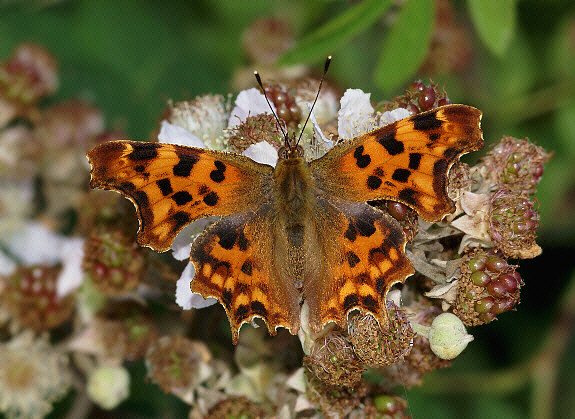 Comma Polygonia c-album, male hutchinsoni, Ballard Down, Dorset – Adrian Hoskins
Comma Polygonia c-album, male hutchinsoni, Ballard Down, Dorset – Adrian Hoskins
Introduction
The Comma was regarded as a common species in the 18th century but declined to became a great rarity between about 1850 and 1910. By 1930 it was on the verge of extinction but then it’s fortunes began to reverse. By the 1980’s its numbers had completely recovered and it is now once again a common species in southern Britain.
The butterfly gets its common name from the C or comma-shaped silver mark on the underside of the hindwings. The genus name Polygonia is a reference to the beautiful ragged wing shape. This is unique among British butterflies but there are other similarly shaped species found elsewhere in the Holarctic region, including the Southern Comma P. egea which inhabits the Mediterranean area, and the Question Mark and Angle-wing butterflies of North America.
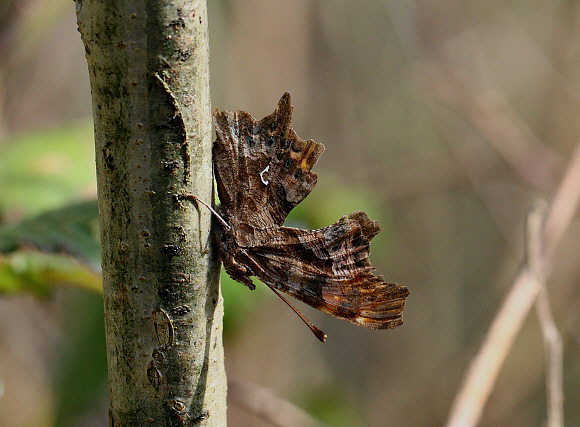
Polygonia c-album, male at roost on birch sapling, Stansted Forest, West Sussex – Adrian Hoskins
The Comma is distributed across most of Europe, but absent from Scotland and sub-arctic regions. Beyond Europe it occurs across temperate Asia to northern China, Korea and Japan. It also occurs in Morocco, Algeria and Tunisia.

Comma Polygonia c-album, male, March, Stansted Forest, West Sussex – Adrian Hoskins
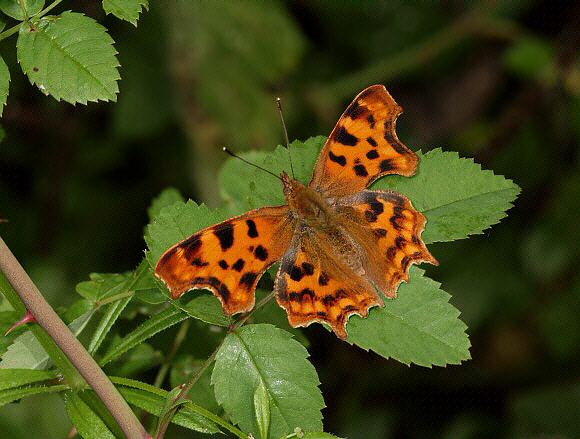
Comma Polygonia c-album, f. hutchinsoni, June, Stansted Forest, West Sussex – Adrian Hoskins
Habitats
In spring Commas breed primarily in woodland edge habitats where stinging nettles grow in damp but sunny situations, typically in glades or at the side of grassy tracks. The summer adults are more mobile however, and can breed in gardens, old quarries, along country lanes and railway cuttings, on sheltered areas of scrubby grassland, and at coastal habitats. They freely roam the countryside and can be found anywhere where stinging nettles or elms grow but favour sunny sheltered sites with bramble bushes nearby, and a profusion of wild flowers.
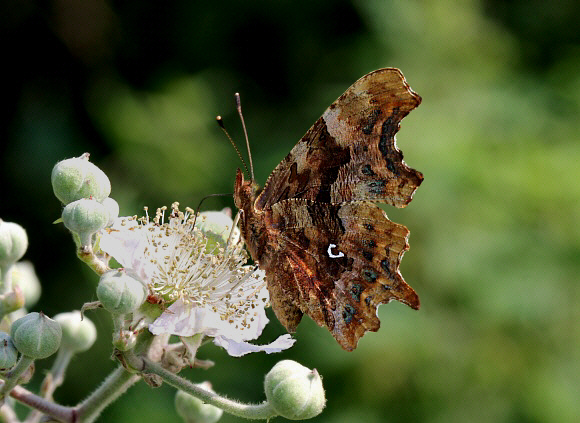 Polygonia c-album, f. hutchinsoni, July, Titchmarsh Wood, Northamptonshire – Adrian Hoskins
Polygonia c-album, f. hutchinsoni, July, Titchmarsh Wood, Northamptonshire – Adrian Hoskins
Lifecycle
There are 2 generations each year. Larvae hatching from eggs laid in early March by overwintered females develop slowly, pupating in mid-June to produce adults of the brightly marked hutchinsoni form. These emerge in early July and remain on the wing until mid-August. The overwintered adults however remain alive until late spring and continue laying eggs until mid-May. Larvae hatching from these later eggs develop more slowly to produce normal adults which emerge in August.
Meanwhile the offspring of the hutchinsoni brood produce another generation of normal adults which emerge in September. In late summer it is possible to see both forms flying together. The hutchinsoni adults die by early September. The normal form adults enter hibernation and awaken the following spring.The green, ribbed eggs are laid singly, close to the edge on the upperside of stinging nettle leaves. Commas normally oviposit on nettles growing in sheltered situations along hedgerows or in sunny woodland glades, close to nectar sources such as blackthorn ( spring ) or bramble ( summer ).
Two hundred or so years ago the primary foodplant used in Britain by Commas was hop Humulus lupulus, which was grown all over southern England as an ingredient for ale. The dramatic decline of the butterfly in the late 19th and early 20th centuries is probably linked to changes of practice which greatly reduced this formerly widespread and abundant plant.
Fortunately the Comma was able to adapt to making widespread use of another foodplant, stinging nettle Urtica dioica and this has now undoubtedly become the primary foodplant in Britain. Larvae are also found occasionally on sucker growth of English elm Ulmus procera, and more rarely on wych elm U. glabra, sallow Salix caprea, hazel Corylus avellana, or cultivated blackcurrant Ribes nigrum.
The fully grown caterpillar is unmistakable, being brownish black, with orange spikes on the front segments, and a long splash of white along the back. It often rests on the upper surface of a leaf, adopting a semi-curled posture, and at a glance can be mistaken for a bird dropping. The chrysalis is marbled in shades of brown, and decorated with spangles of silver and gold. I have occasionally found pupae attached to fence posts, but they are more often found suspended from woody stems or shaded tree trunks.
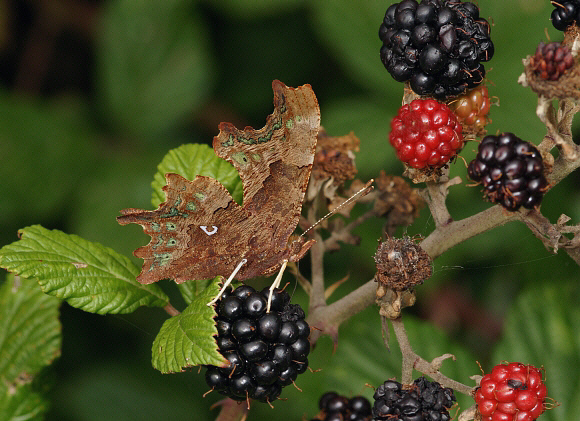 Comma Polygonia c-album, Steyning, West Sussex – Adrian Hoskins
Comma Polygonia c-album, Steyning, West Sussex – Adrian Hoskins
Adult behaviour
In spring Commas occupy ride intersections and glades, where they nectar at blackthorn blossom, sallow catkins and dandelions. They spend long periods basking on leaf litter, bare ground, on logs, or on bramble leaves or dead bracken. It is also common to see them basking head-downward on fence posts, or on the trunks of birch and ash trees.
In the spring males establish territorial perches on twigs, logs or favoured leaves which they use as bases from which to launch flights to ambush other passing butterflies. Intruding male Commas and butterflies of other species including Peacocks and Orange tips are always ousted by the ‘owner’ of the territory. Summer brood Commas often perch on hazel bushes and intercept Gatekeepers and Speckled Woods. Passing female Commas are intercepted, but I have never witnessed a courtship ritual, or found any mated pairs. Copulation reportedly takes place high in the tree tops.
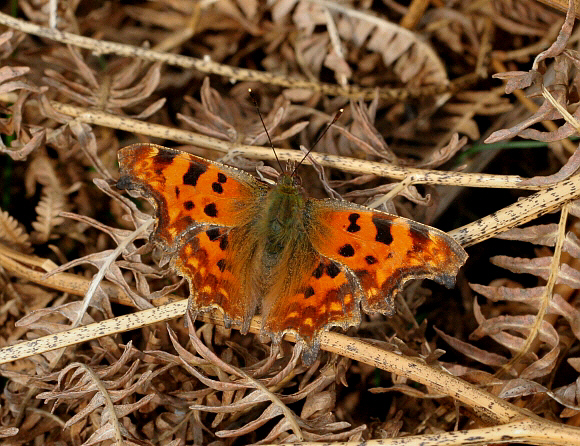
Comma Polygonia c-album, Stansted Forest, West Sussex – Adrian Hoskins
On warm sunny days in spring, butterflies of both sexes frequently settle on paths, tree stumps or wood shavings to imbibe moisture. Summer nectar sources include bramble, hemp agrimony, wild carrot, marjoram, thistles and traveller’s joy.
In cool cloudy weather, Commas roost openly on foliage, and if disturbed will feign death, falling to the ground, with their wings closed and their white legs tucked tightly against their bodies. Towards dusk they seek overnight roosting sites. One evening in early July 2009, I watched a female settling down to roost – she spent a couple of minutes fluttering around on the shady side of an ivy covered fence, and eventually settled for the night under an ivy leaf, resting on the mid-vein, with her head pointing towards the stem.
On various occasions I have also found Commas roosting at ground level among grasses – in these cases the butterflies always roost head-downward. Their disguise is quite remarkable, giving the impression of a dead oak leaf that has fallen onto the grass.
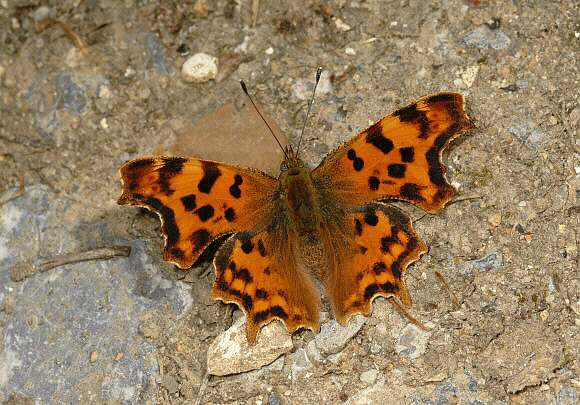
Comma Polygonia c-album, July, Alice Holt forest, Hampshire – Adrian Hoskins
In early autumn the butterflies nectar avidly at devilsbit scabious, buddleia, ragwort and fleabane in preparation for hibernation. The feeding frenzy continues into September and October when they nectar at ivy, and gorge themselves on sugary juices exuding from fermenting blackberries.
In late October they seek out hibernation sites, usually choosing to spend the winter months hiding in wood stacks, hollow tree trunks, or sometimes out in the open, hanging beneath branches. The butterfly depicted below was found hibernating under a branch of young coppiced sweet chestnut, about 0.5m above ground level in Stansted Forest.
I found it on 26th January 2008 but suspect that it had been hibernating there since the previous October. It was still there in the same position on 9th February, but by 24th February had disappeared, presumably having awoken from it’s diapause with the arrival of sunny and slightly warmer weather.
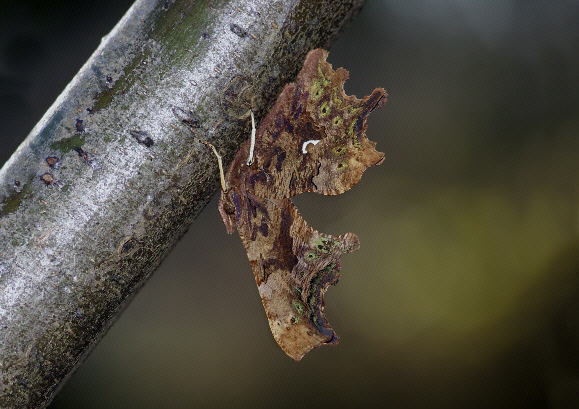
Comma Polygonia c-album, hibernating openly under a low branch – Adrian Hoskins
